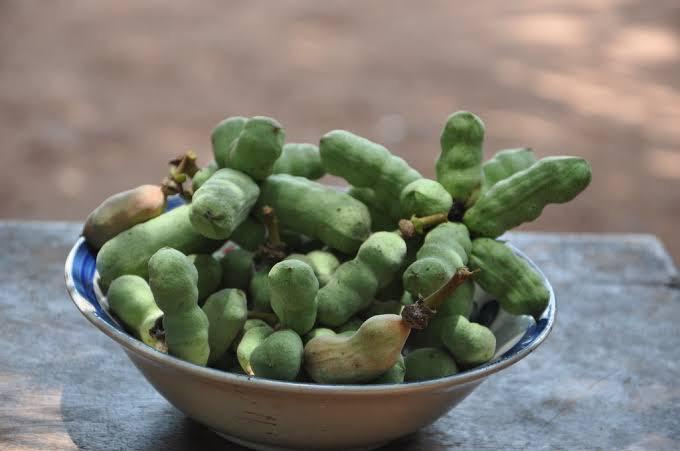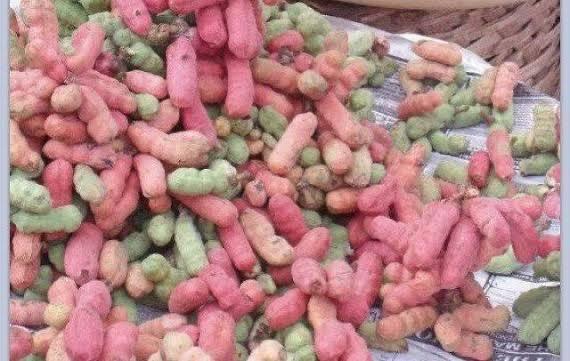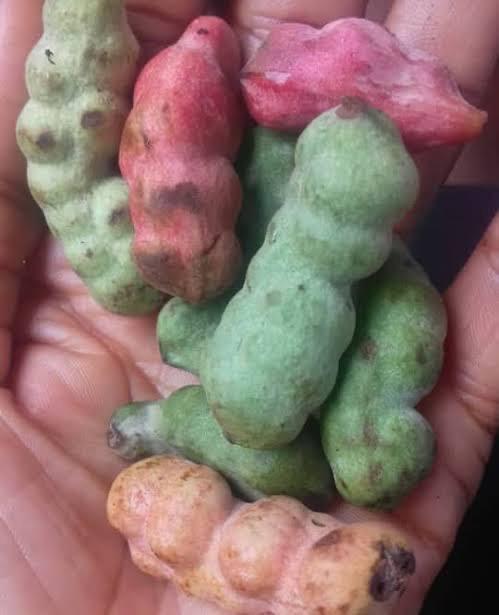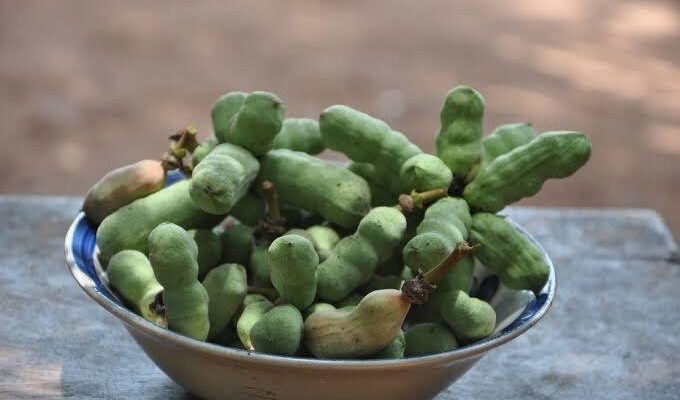It is botanically known as Dennettia tripetala.
In igbo land, it is called mmimmi.
It is a pungent, pepperish, spicy medicinal plant that is characterised by greenish appearance when unripe but tends to be reddish or pinkish in colour when ripe.
 The fruit usually ripens between April and May. Edible mature pepper fruit is mostly chewed raw but can also be used for food preparations and for preparing herbal medicines. Both the fruits, leaves, roots and barks of the Dennettia tripetala plant are distinguished by their strong pungent, spicy and pepperish taste, fragrance and aroma (Achinewhu et al, 1995).
The fruit usually ripens between April and May. Edible mature pepper fruit is mostly chewed raw but can also be used for food preparations and for preparing herbal medicines. Both the fruits, leaves, roots and barks of the Dennettia tripetala plant are distinguished by their strong pungent, spicy and pepperish taste, fragrance and aroma (Achinewhu et al, 1995).
The leaves can be dried and stored for a long period of time without any microbial attack. According to Okwu and Morah (2004), Dennettia tripetala fruits can serve as food and herbs for producing herbal medicines. Both the fruits, leaves and roots of the pepper fruit are useful for medicinal purposes Iwu (1989). Pepper fruit is normally chewed as a fruity snack due to its peppery stimulating effects. It is normally served together with palm wine, garden eggs, bitter kola and kola nuts during festivals, cultural ceremonies, coronations, traditional marriages, naming ceremonies, new yam festivals and special events in the eastern part of Nigeria.
7 Benefits of Mmimmi (Pepper Fruit Dennettia tripetala).
 1. Nutritional Benefits Okwu and Morah (2004) study shows that Dennettia tripetala contains 0.42% magnesium, 1.80% calcium, 2.50% potassium, 9.84% crude fibres, 15.31% crude protein, 8.0% moisture, 62% carbohydrate, 3.47% crude lipids, 0.33% phosphorus, trace elements such as cadmium, iron, zinc and copper. Pepper fruit also contains water-soluble vitamins such as niacin, ascorbic acid, riboflavin and thiamine. Ihemeje et al., (2013) study shows that unripe pepper fruit contains higher amount of vitamin C, vitamin A and minerals more than the ripe ones. Thus it is highly recommended that people should consume Dennettia tripetala due to its high nutritional values. Nwaogu et al. (2007) studied the phytochemical content of the pepper fruit and their results showed the presence of cyanogenic glycosides, saponins, tannins and flavonoids in this fruit. Both the fruit and the leaves were found to contain secondary metabolites such as phenol, carbohydrate, terpenes, flavonoids, tannin and alkaloids.
1. Nutritional Benefits Okwu and Morah (2004) study shows that Dennettia tripetala contains 0.42% magnesium, 1.80% calcium, 2.50% potassium, 9.84% crude fibres, 15.31% crude protein, 8.0% moisture, 62% carbohydrate, 3.47% crude lipids, 0.33% phosphorus, trace elements such as cadmium, iron, zinc and copper. Pepper fruit also contains water-soluble vitamins such as niacin, ascorbic acid, riboflavin and thiamine. Ihemeje et al., (2013) study shows that unripe pepper fruit contains higher amount of vitamin C, vitamin A and minerals more than the ripe ones. Thus it is highly recommended that people should consume Dennettia tripetala due to its high nutritional values. Nwaogu et al. (2007) studied the phytochemical content of the pepper fruit and their results showed the presence of cyanogenic glycosides, saponins, tannins and flavonoids in this fruit. Both the fruit and the leaves were found to contain secondary metabolites such as phenol, carbohydrate, terpenes, flavonoids, tannin and alkaloids.
2. Edible Purposes Dennettia tripetala fruit can be used as a pepperish spice for seasoning and flavouring food such as white soup, spicy fish, hot drinks, alcoholic drinks, beverages, meat, vegetables, stew, sauces and sausages; pepper fruit is a good substitute for ginger in zobo drinkproduction.
3. Post-partum Care Achinewhu et al., (1995) reveal that pepper fruit seeds are essential for preparing food for newborn mothers immediately after childbirth as the spice aids uterus contraction. Pepper fruit can be used together with scotch bonnet peppers, piper guineese, utazi for hot soup preparations for new mothers.
3.Antinociceptive Effects.
Pepper fruit has antinociceptive effects and as such can be used for reducing sensitivity to painful stimuli.
 4.Insecticidal Purposes
4.Insecticidal Purposes
Akinbuluma et al., (2015) study shows that pepper fruit can be used for producing insecticides. The plant products are effective against pests, insects, Sitophilus zeamais (Motsch.), maize weevil. The insecticidal activities of this plant can be attributed to its pungency and pepperish nature.
5.Treatment of Infantile Convulsion
The leaves and fruits of the pepper fruit can be used for preparing herbal medicines for treating infantile convulsion. Infantile convulsion is a neurological genetic disorder notable for its autosomal dominant mode of inheritance. It is associated with benign familial infantile epilepsy (BIFE) especially between the age of three to twelve months and paroxysmal kinesigenic choreoathetosis later in life.
6.Insecticidal Purposes
Akinbuluma et al., (2015) study shows that pepper fruit can be used for producing insecticides. The plant products are effective against pests, insects, Sitophilus zeamais (Motsch.), maize weevil. The insecticidal activities of this plant can be attributed to its pungency and pepperish nature.
 7.Treatment of Infantile Convulsion.
7.Treatment of Infantile Convulsion.
The leaves and fruits of the pepper fruit can be used for preparing herbal medicines for treating infantile convulsion. Infantile convulsion is a neurological genetic disorder notable for its autosomal dominant mode of inheritance. It is associated with benign familial infantile epilepsy (BIFE) especially between the age of three to twelve months and paroxysmal kinesigenic choreoathetosis later in life.




